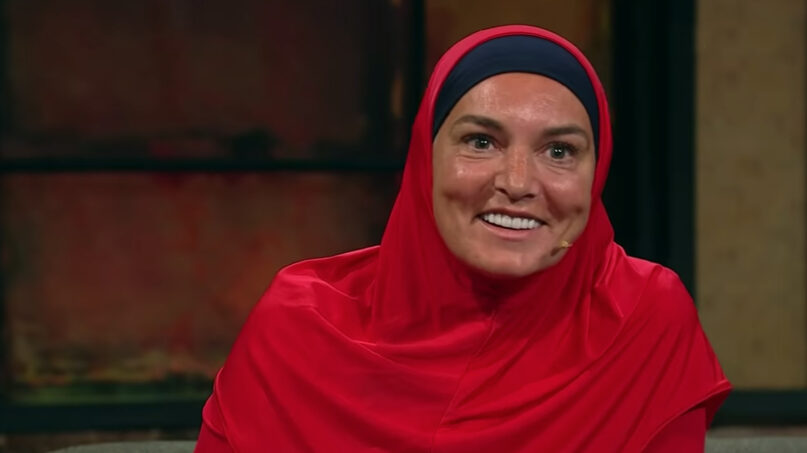Sinead O’Connor was a rock star and a Muslim. Why did obituaries miss this?
Obscuring O’Connor’s faith is a missed chance to fight Islamophobia.

(RNS) — Sinead O’Connor, the Irish singing star whose funeral was held Tuesday (Aug. 8) near Dublin, will always be connected with Roman Catholicism after she ripped a photo of Pope John Paul II in two on “Saturday Night Live” in 1992 to protest the church’s handling of sexual abuse by priests. The backlash dampened her success, and though she said she didn’t regret the moment, it defined her public image for the rest of her 56 years.
But the rites for her burial Tuesday were not Catholic but Muslim, and Sheikh Umar Al-Qadri, an Islamic scholar and the chief imam at the Islamic Center of Ireland, eulogized her as Shuhada Sadaqat, the name she took after converting to Islam. It’s not something the news media have reported much about, part of a seemingly willful ignorance that was more interested in her reputation as a rebellious and even sacrilegious celebrity.
For a long time, O’Connor’s relationship with religion was complicated. Many recent retrospectives, such as here and here, published after her death, comment on her spirituality. She was indeed repelled by much about religion, particularly inflexible religious labels. Yet she was constantly attracted to spirituality, and it powered her creative work. Her album “Theology” contains Hebrew Bible texts that she rearranged and set to music. In 2007, she declared that she had become a Rastafarian.
And she kept up her sometimes contentious conversation with Catholics. Tapping into the debate about women’s priesthood, she caused controversy in April 1999 when she announced she had become ordained as the first-ever priestess in the Latin Tridentine Church, a dissident Catholic group in her native Ireland. In 2019, she reflected on Catholic-dominated Ireland in an interview on “The Late Late Show”: “It was a very oppressed country, religiously speaking.”
But O’Connor’s seeking phase ended when in 2018 she embraced Islam. What she told of that process was evocative of a statement I heard dozens of times from converts to Islam I interviewed for my book, “Wearing the Niqab: Muslim Women in the UK and the US.” In her interview on “The Late Late Show,” she said: “I had been a Muslim all my life and didn’t realize it. … I am home.”
This fact, that it was Islam that finally brought her peace, has been neglected entirely or treated as a footnote.
Her obituary in Vogue does not mention her Muslim faith at the time of her death but makes an obligatory note of the photo-tearing incident. The New York Times, The Washington Post and the Chicago Sun-Times all made only brief asides saying that she had converted and changed her name. (In its story today, The New York Times included more about her Muslim funeral.)
Her obituary in The Guardian, a British daily that usually aspires to be diversity-affirming, was puzzlingly insensitive when it came to noting her faith: “On her final concert tour, in 2019, she wore a hijab and abaya, but nothing else had changed — her voice still raised the hair on the back of the neck.”
Why would her voice or her talent change after conversion? Does the author imply that a Muslim woman would have less power as a performer? This statement feeds into prevalent stereotypes of Muslim women as silent and oppressed.
On its X (formerly Twitter) account, the Council on American-Islamic Relations argued that photos used in her obituaries — many of them pre-conversions photographs of O’Connor with bare arms and her head uncovered — would be counter to O’Connor’s adoption of a hijab and abaya.
Another CAIR post said, “We also urge the media to respect her acceptance of Islam by acknowledging the name she chose for herself, Shuhada’ Sadaqat, & using recent photos that depict how she chose to present herself.”
This sentiment was echoed by Khaled Beydoun, a prominent scholar of Islam: “Many Mainstream media outlets are overlooking or erasing Sinead — or Shahuda’s — Muslim identity.” (Another scholar of Islam, Amanullah De Sondy, points out that O’Connor’s gender-fluid identity is similarly being erased by the very same media outlets.)
O’Connor often used her birth name as a stage name, so using it for clarity is understandable. But to focus completely on her conflicted relationship with Catholicism oddly fails to explore what came after her entanglement with the religion of her homeland, and the religion that eventually brought her peace after a tumultuous faith journey.
The obscuring of O’Connor’s Muslim faith by the mainstream media suggests that the Islamic faith is still seen as somehow incompatible with show business. Few Muslim female singers reach global fame on this scale, so it is disappointing that so few in the media saw O’Connor’s brilliant life as a chance to challenge Islamophobia. But more disappointing is that in remembering her, something so important as her religious agency — her religious choice, belief, practice and identity — was seen as an afterthought.
(Anna Piela, a visiting scholar in religious studies and gender at Northwestern University, is the author of “Wearing the Niqab: Muslim Women in the UK and the US.” She is also the senior writer at American Baptist Home Mission Societies and an ordained American Baptist Churches USA minister. The views expressed in this commentary do not necessarily reflect those of Religion News Service.)
No comments:
Post a Comment